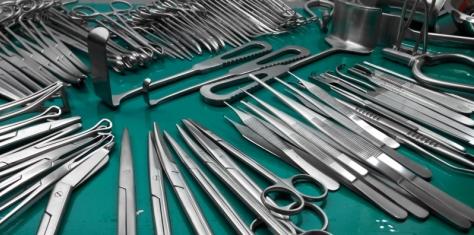The history of surgery and surgical procedures goes back to the ancient world. There is evidence of surgical procedures being undertaken even as far back as 3000 BC. Surgery has come a long way since then. The understanding of human anatomy, its nuances, surgical routines, medicines, hygiene standards, and infrastructure have improved radically. Today we use very advanced technology for surgical precision and such operations are largely pain and risk-free. In all this, surgical implements and devices have also evolved considerably. While specialized surgeries demand highly specialized equipment, the majority of the instruments used in general surgery can be classified into these heads
Cutting and dissecting instruments - Cutting and dissecting is the preliminary part of a surgical procedure. The scissors, scalpels, and saws are traditionally used to cut through the skin tissue and into the organ being operated on.These instruments are also used to cut away sore or diseases tissue and tumours. These are very sharp and often require regular replacement.
Grasping or holding instruments - As the name suggests, grasping and holding instruments are used to hold tissue back or to hold blood vessels that may be in the way of the surgery site. One of the commonest grasping and holding instrument used in surgery is a pair of forceps. These are quite often blunted instruments with jagged edges that can be held with the fingers.
Retractors- Retractors are surgical instruments that are used to retract or pull back the skin, tissue, or organ once an incision has been made. This helps expose the surgical site to the surgeon. Usually a single surgery involves use of several retractors which may be either self-retaining or can be held by a nurse or an assisting surgeon.
Haemostatic instruments - Haemostatic instruments are clamps similar devices that help in the compression of blood vessels to prevent excess blood flow to the surgical site. Sometimes these occluding instruments are also used to close or shut a blood vessel. Mosquito forceps and haemostats are some commonly used clamping instruments.
Tissue unifying instruments–After the surgery is performed it is important to close up the site carefully and with utmost precision. This helps in quick healing and prevents infection. Tissue unifying instruments include needles and materials such as staples and sutures. These come in various specifications and are chosen according to the site and organ operated upon.
Regular use of medical devices such as the Littman stethoscope have also evolved considerably. It only stands to reason that most surgical implements also come in various materials and specifications. With the introduction of laser surgery systems there are a number of other surgical devices that have come to be used these days. It is important to understand and plan the nuances of any surgical procedure to be aware of the instruments that shall be required during the operation.
Now that we have an understanding of the classification of surgical implements, it is also important to understand that a surgeon is just as good as his/her instruments. This makes it important to source these medical implements from highly reliable medical suppliers. Fortunately, these days a number of websites such as the Smart Medical Buyer offer high-quality medical supplies making it easy to buy medical devices online. Most medical equipment manufactured by popular manufacturers conform to very high quality standards set by medical associations. It is, however, important to check with the doctor performing the surgery about his/her preferences.






